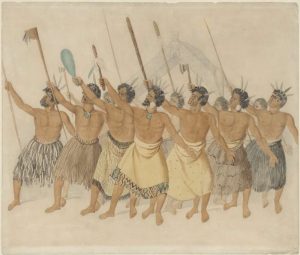Australia, Papua New Guinea, Sahul
Oceania and the Pacific Ocean are the last area of our journey. Evidence of tools from 30,000 years ago exists in Australia, and from even longer in New Guinea. The lack of “a dry land crossing to Sahul” (the land mass that once connected New Guinea and Australia) meant that an ocean journey of somewhere between sixty-five and 100 kilometers was required from mainland Asia. This made Australians and New Guineans the first sea-going colonizers. Once in Sahul, how humans populated Australia is still the subject of some debate between those who support the “coastal hugger” theory and those who support the idea of population by “overlanders.” The more difficult of the two means of populating Australia is overland, as it is more arid than the coasts, and the evidence for tools overland is not as advanced as that for the coast.
Increased sophistication as discussed in Module 1 was not limited to big game hunters. Campsites, rock art, and burial sites near Lake Mungo in Australia reveal how these early humans used pottery for cooking and had a diverse diet of birds, fish, and shellfish, a diet that seems to have kept them well-nourished.[1] Australia was a society of hunter-gatherers until European colonization. Mobility was essential, with the continent’s lack of widespread rainfall and rich soil. As a result, aboriginal Australians needed an extensive knowledge of their terrain and where to move when. Tasmanians would ambush wallabies at their seasonal grazing territory, while aborigines in the central deserts had to know when water holes would go dry. We also learn from the remains of Australian aborigines that foragers could be quite complex if they continued to hunt and gather for thousands of years. Aborigines painted, developed advanced weapons like the boomerang, warred against one another, developed creation myths, passed down oral histories, and played musical instruments.
To learn more about the people of New Zealand, Australia, Polynesia and other peoples of Oceania watch the video below on the DNA Project.
Made in Taiwan: Genes, Culture, and the Peopling of the South Pacific. 2006. Accessed May 3, 2020. https://ccco.idm.oclc.org/login?url=https://fod.infobase.com/PortalPlaylists.aspx?wID=151823&xtid=40078. 44:44.
Polynesia

Asia was not the only settled area in the East. The other areas around the Pacific Ocean were also settled. The origins of Polynesian humans are still very much in doubt. Groups of Polynesian mariners had existed 50,000 years ago, but they were not colonizers. In fact, many scholars argue that eventual colonization actually began as exploration. Around 2,500 years ago, we see more permanent settlements in Fiji, Tonga, and other areas of the “remote” Pacific, as remnants of pottery have been found there. Based on linguistic and technological similarities among Polynesian cultures, some scholars argue that Fiji, Somoa, and Tonga were a crucible of sorts where Polynesians were “made” from groups from throughout Asia. Once these cultural groups had a certain identity, they began to colonize Easter Island, Hawaii, and New Zealand about and beyond 1,000 CE.
“Humans Arrive in Hawaii.” Hawaii’s Fatal Attraction. 1991. Accessed May 3, 2020. https://ccco.idm.oclc.org/login?url=https://fod.infobase.com/PortalPlaylists.aspx?wID=151823&xtid=49700&loid=200027 . 0:52.
Key Question
- How was Polynesia – made up of hundreds of islands – actually settled?

Maori War Dance, Joseph Jenner Merrett, 1850, National Library of Australia/Trove
We can’t use land migration patterns to understand oversea migration. The Pacific was somewhat of a highway, where currents and winds were well-known and frequently used by mariners. Migrating humans were much more likely to wander aimlessly on land than they were to let currents take them to unknown parts of the ocean. Pacific mariners tacked to use the winds in their favor and, despite population pressures, Pacific mariners were too adept at seafaring to suggest a simple casting out of people into the Pacific in hopes of finding something. Once Pacific colonization did commence, settlers were very deliberate about it, taking with them families, and plants, and animals. It seems that they had every intention of recreating “home.” In sum, the exploration was neither extremely heroic nor extremely risky but instead was calculated and not left to chance.
Read and explore the naval skills of these ancient peoples at the links below and watch the brief video clip on Polynesian navigation skills.
- “Polynesians: An Oceanic People”
- “The Indian Ocean: A Maritime Trade Network”
- “Ancient Chinese Explorers”
“Western Versus Polynesian Navigation.” Windows on the World. 2010. Accessed May 3, 2020. https://ccco.idm.oclc.org/login?url=https://fod.infobase.com/PortalPlaylists.aspx?wID=151823&xtid=43450&loid=101263. 5:53.
It seems fitting that we end our journey with a mystery. Polynesia stretches from New Zealand to Hawaii and contains hundreds of islands. Easter Island, located off the coast of Chile in South America has presented a mystery for scholars ever since its European discovery in the 1700s. Read this article published by NOVA and explore the links provided. Then watch the video to explore the history of this fascinating place and the connections of this Polynesian exploration with other islands in the Pacific.
Easter Island in Context: From Paradise to Calamity. 2002. Accessed May 3, 2020. https://ccco.idm.oclc.org/login?url=https://fod.infobase.com/PortalPlaylists.aspx?wID=151823&xtid=30091. 51:05.
[1] Lauren Ristvet, In the Beginning: World History from Human Evolution to the First States (Boston: McGraw Hill, 2007), 27 – 30.

